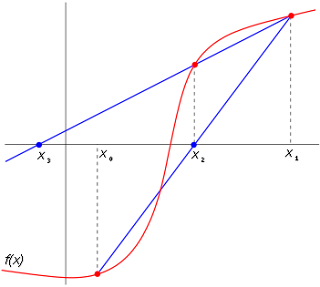In numerical analysis, the secant method is a root-finding algorithm that uses a succession of roots of secant lines to better approximate a root of a function f. The secant method can be thought of as a finite difference approximation of Newton's method. However, the method was developed independent of Newton's method, and predated the latter by over 3000 years. 
The secant method is defined by the recurrence relation
As can be seen from the recurrence relation, the secant method requires two initial values, x0 and x1, which should ideally be chosen to lie close to the root.
Example
#include#include double f(double x) { return cos(x) - x*x*x; } double SecantMethod(double xn_1, double xn, double e, int m) { int n; double d; for (n = 1; n <= m; n++) { d = (xn - xn_1) / (f(xn) - f(xn_1)) * f(xn); if (fabs(d) < e) return xn; xn_1 = xn; xn = xn - d; } return xn; } int main(void) { printf("%0.15f\n", SecantMethod(0, 1, 5E-11, 100)); return 0;
form f(x) = cos(x) − x3 = 0
After running this code, the final answer is approximately 0.865474033101614. The initial, intermediate, and final approximations are listed below, correct digits are underlined.

No hay comentarios:
Publicar un comentario